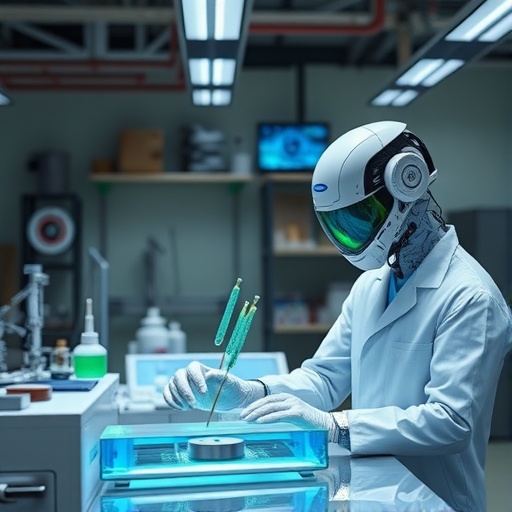In an unprecedented move blending artificial intelligence and robotics, researchers at the University of Chicago’s Pritzker School of Molecular Engineering have developed an autonomous laboratory system capable of independently producing thin metal films. This innovative “self-driving” lab addresses the longstanding challenges in materials science, specifically in the difficult and tedious process of creating thin films essential for a variety of electronic, optical, and quantum technologies. Traditional methods often involve exhaustive trial-and-error experimentation, consuming months of time and resources. Now, with this cutting-edge system, scientists can streamline the entire process, significantly reducing the time and effort required while enhancing predictability and accuracy in outcomes.
The intricate process of physical vapor deposition (PVD), where materials like silver are heated until they vaporize and then condense into ultra-thin films, has posed significant challenges for researchers. Variations in environmental conditions, temperature, and material composition can drastically influence the final product, making it difficult for scientists to replicate successful results consistently. This new system incorporates advanced robotics to handle samples, combined with a machine-learning algorithm that accurately predicts the necessary parameters for desired outcomes. The result is a paradigm shift in the manufacturing and discovery of advanced materials.
Leading the research is Yuanlong Bill Zheng, an undergraduate turned PhD student, whose insights into the frustrations faced by researchers led to this groundbreaking initiative. The goal was not only to automate the monotonous tasks associated with the experimentation process but also to enhance the depth and breadth of materials exploration. By automating the entire loop of experimentation—from running tests to measuring results—this self-driving lab system represents a pivotal evolution in the realm of materials synthesis.
The coordinated interaction between robotics and machine learning is at the heart of this project. After the initial assembly of the robotic system, which operates each step of the PVD process, the team collaborated closely with computer science experts to develop a sophisticated algorithm that can leverage past experiment data to predict optimal conditions. The ability for a researcher to specify their desired output and have the system autonomously navigate experiments is a game-changing feature of this technology.
Another outstanding aspect of this system is its adaptability in addressing the unpredictable nuances that can arise during the PVD process. In experimental setups, unique conditions such as slight variations in substrate composition or unfortunate gas ratios in the vacuum chamber can lead to inconsistencies. To mitigate this, the self-driving lab employs a calibration layer technique before commencing any experiment, allowing the algorithm to adjust and respond to these variations systematically and quantitatively.
Zheng emphasizes the systemic capture of these variances as a significant leap forward in reliability for PVD techniques. With traditional manual methods, researchers frequently encounter irreproducibility due to subtle factors that influence their experimental outcomes, introducing noise into their training data for predictive models. The new autonomous setup, however, systematically collects and interprets these variations, yielding a stable groundwork for developing machine learning models that can successfully guide future experiments.
Proving the efficacy of their innovative creation, the researchers tasked the autonomous system with growing silver films exhibiting specific optical properties. Testing this approach on silver—a well-studied but not easily perfected material—allowed for a compelling demonstration of the lab’s capabilities. Amazingly, the setup accomplished the targeted outcomes in an average of only 2.3 attempts, outperforming what would typically require weeks of painstaking human effort and troubleshooting.
Cost-effectiveness is another striking feature of this project. The entire setup, costing less than $100,000, marks a significant reduction in expenses compared to prior endeavors by commercial laboratories attempting to create similar self-driving systems. This financial viability paves the way for broader adoption of such technologies, making advanced material synthesis more accessible to the scientific community.
As this platform evolves, the team envisions expanding its capabilities to incorporate more complex materials essential for advanced electronics and quantum device manufacturing. The implications of this research are profound: not only does it streamline the process for thin film production, but it also heralds a new era in materials discovery and synthesis that leverages the partnership between human ingenuity, robotics, and artificial intelligence.
This research could revolutionize the materials science field, opening doors to unprecedented advances in technology and innovation. The autonomous lab embodies a futuristic vision where AI is not merely a tool but a collaborator in scientific exploration.
As the study published in npj Computational Materials signifies, this foundational work has far-reaching potential. The implications of employing self-driving laboratories could redefine how we think about and approach materials research in the future. By reducing human labor demands and enhancing accuracy and efficiency, this technology could dramatically accelerate the pace of scientific discovery across various disciplines.
The drive to automate laborious processes in scientific research is not just about efficiency; it is about expanding the horizons of possibility in materials science. As artificial intelligence becomes more integrated into research frameworks, the ability to innovate and discover new materials could become faster and more efficient than ever before.
Harnessing the capabilities of technology to transform materials synthesis could lead to breakthroughs that are currently unfathomable. With this innovative self-driving lab, the future of scientific research in materials engineering looks promising, paving the way for advancements that could shape countless industries.
Subject of Research: Autonomous laboratory systems for thin film synthesis using artificial intelligence and robotics
Article Title: A Self-Driving Physical Vapor Deposition System Making Sample-Specific Decisions on the Fly
News Publication Date: 5-Nov-2025
Web References: npj Computational Materials
References: Zheng, Yuanlong, et al. “A Self-Driving Physical Vapor Deposition System Making Sample-Specific Decisions on the Fly.” npj Computational Materials.
Image Credits: John Zich
Keywords
Applied sciences and engineering, Research methods, Materials science, Materials engineering, Fabrication
Tags: artificial intelligence in researchautomation in scientific researchautonomous laboratory technologychallenges in thin film creationenhancing predictability in materials manufacturinginnovative approaches to material sciencemachine learning for experimental outcomesphysical vapor deposition advancementsrobotics in material growthself-driving lab for materials sciencethin metal film productionUniversity of Chicago materials engineering





